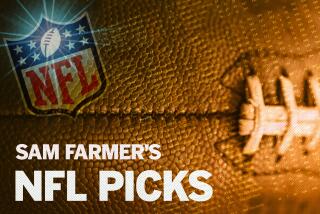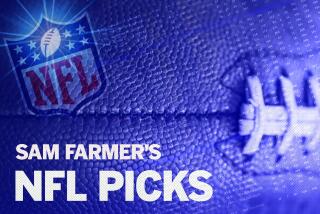Pro Football : Winners Weather the Competition
- Share via
At Green Bay last Sunday, the surprising defeat of the Minnesota Vikings underlined a curious new fact about life in the National Football League.
This is a league that is slowly but obviously dividing itself into hothouse teams and outdoor teams.
The hothouse bunch includes pro clubs playing home games in domed stadiums or in the milder weather of Southern California and Florida.
These teams have been experiencing big trouble this winter in cold-weather outdoor stadiums.
And outdoor teams have been having trouble winning indoors.
The league has become so well balanced--it’s called parity--that non-football factors are deciding many key late-season games.
Clearly, the most influential of these factors are the climate outside and the noise inside--the din created by partisan home-team crowds in domed stadiums.
In the Viking-Packer game, which matched possibly the best and worst of the 28 NFL teams, the league was shocked by the result. The Vikings, leaving the comfort of their home dome in Minneapolis, couldn’t adjust to a freeze and collapsed, 18-6.
“I don’t think there’s any question that it’s difficult for any (team) to adjust to extreme cold after playing all year in a good environment,” Viking General Manager Mike Lynn said Tuesday.
“Football is a different game on a bad field or (in) bad weather.”
In successive games, the Seattle Seahawks have played a reasonably good team (Raiders) at home and a reasonably good team (New England) away.
The results: With the help of their noisy fans, the Seahawks beat the Raiders in the Kingdome, 35-27, on a night when two Seattle backs gained more than 100 yards apiece. A week later, in Arctic-like weather at Foxboro, Mass., the Seahawks were lucky to get a touchdown against the Patriots and totaled only two first downs in a 13-7 loss.
The NFL is getting to be that kind of league. It isn’t the hometown advantage that’s decisive.
Instead, look to the following:
--The home-crowd advantage, for those playing in domes.
--The home-ice advantage for the cold-weather teams that get to entertain hothouse teams on winter days.
Thus, in a meeting of closely matched American Conference favorites, the Cincinnati Bengals lost big indoors at Houston Sunday, 41-6.
The Chicago Bears, playing outdoors with an ineffective third-string quarterback, turned back the hothouse Detroit Lions, 13-12, in a Soldier Field freeze.
The hothouse Raiders, who could win the championship of the AFC West this week, were blind-sided outdoors in frigid Buffalo, 37-21.
In late November, the same Bills couldn’t win on good football days in Cincinnati or Tampa.
The Cleveland Browns, a first-class cold-weather team, couldn’t win in Miami Monday night. And they couldn’t win in Houston’s dome a few weeks ago.
The formula isn’t foolproof. But a trend is there.
In the 1988 playoffs, the New York Giants are the NFC’s unknown quantity. Playing the easiest schedule in their division this season, they’ve struggled most of the way, and haven’t earned anything yet, neither a division title nor a wild-card invitation.
But at times--like Chicago, Minnesota, Philadelphia, San Francisco, New Orleans and the Rams, all of whom are also still in the race--the Giants have played impressively.
“We’ve been starting our first three draft choices recently--two of them in the offensive line,” said Giant General Manager George Young, identifying guard Eric Moore of Indiana, tackle John Elliott of Michigan and linebacker Sheldon White of Miami of Ohio.
“That will make a difference next year,” Young said.
And maybe this year, as well.
Before the Green Bay game, the Vikings seemed to be on a straight, short road to the Super Bowl. Now the road is longer and tougher.
Even so, the Vikings figure to come in as the NFL’s best wild-card team since the 1980 Raiders, who won 4 straight in the playoffs and toppled Philadelphia in the Super Bowl, 27-10.
Now that the Bears have been brought down by injuries, the Minnesota defense is almost surely the strongest in the conference. And on offense, the Vikings are about as good as any.
They can beat the Bears in Soldier Field, if they both get to the NFC title game.
In the AFC, Houston still seems to have the best players and Cincinnati the best team. But the tournament road runs through an ice box at Buffalo.
In the last week of the regular season, the difference between the two Los Angeles area teams--in playoff terms--is that the Rams have been scheduled out of town and the Raiders at home.
Ram Coach John Robinson is right about this: Once again, his team will be at a disadvantage in the important 16th game at San Francisco.
The Raiders, meanwhile, have the edge at the Coliseum against Seattle.
It’s an edge that will crumble swiftly, of course, if their offensive linemen and defensive players compete as ineffectively as they have lately.
Probably the best thing about the Raiders is the improvement that quarterback Jay Schroeder has shown since returning to the lineup.
What has happened is that after 3 months in Los Angeles, Schroeder is more familiar with the design of Coach Mike Shanahan’s offense.
Schroeder won’t be really comfortable on this team, of course, until he has spent an off-season mastering the nuances of the Raiders’ system.
In any case, if you think the Raiders haven’t made up much ground this season, remember this: Sixteen weeks ago, they didn’t even have a quarterback. Or so it was perceived.
Today, in Schroeder and Steve Beuerlein, they have a pair.
That’s progress.
More to Read
Go beyond the scoreboard
Get the latest on L.A.'s teams in the daily Sports Report newsletter.
You may occasionally receive promotional content from the Los Angeles Times.










